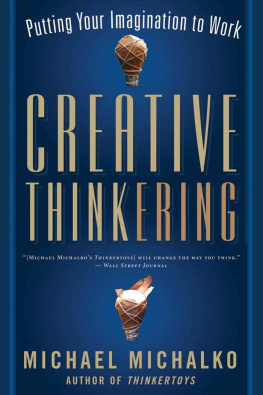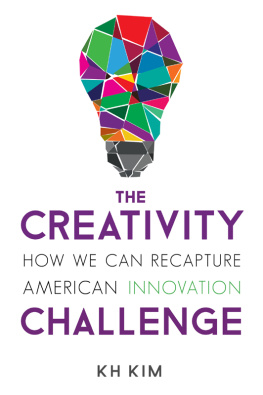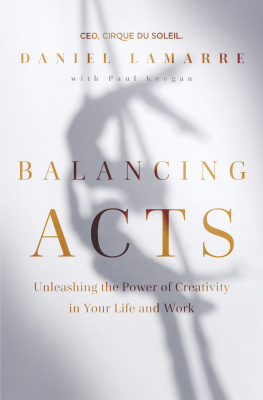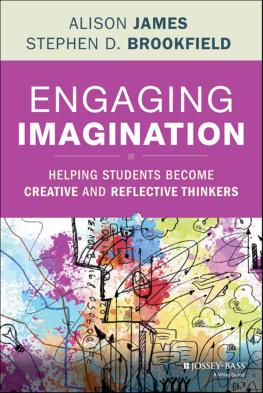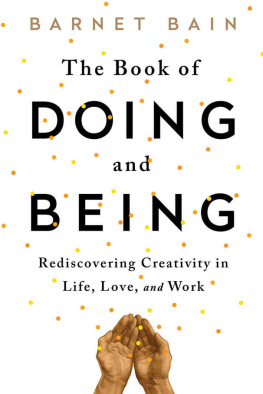MORE PRAISE FOR CREATIVE THINKERING
Creative Thinkering is a wonderfully entertaining operators manual for your creative brain. Turn to any page, and the idea machine in your head cant help but start manufacturing new ideas!
Bryan Mattimore, author of
The Idea Engine and president of the Growth Engine Company
A real gem Thought-provoking and interactive, Creative Thinkering bridges the perception gap and opens up creative vistas even for those who dont believe they have the creative gene. Packed with information about the nature of creativity and absolutely loaded with germane and fun visuals, its access to creativity served up on a silver platter.
Gregg Fraley, author of Jacks Notebook
Creative Thinkering offers a fresh look at creativity, from spontaneous to deliberate. Based upon his extensive study of and professional work in creativity and creative-thinking tools, Michael Michalko has once again written an excellent book to help people discover their creativity including how to better understand it and how to expand and deepen it too.
Robert Alan Black, PhD, CSP, author of
Broken Crayons: Break Your Crayons and Draw Outside the Lines
As much as I totally immerse myself in reading more about creativity, I always learn something new, fascinating, and very valuable from Michael Michalko. His newest books focus on powerful conceptual blending techniques and his mind-expanding illustrations and experiments for the reader make this book a new standard of discovery and thinking excellence for the aspiring creative genius in all of us.
Ray Anthony, innovation consultant and author of
F-A-S-T Forward and Step on It!
A superb book! Read Creative Thinkering and begin to apply it immediately. Your professional and personal life will be opened to new and unimagined possibilities.
Connie Harryman,
President of the American Creativity AssociationAustin Global
PRAISE FOR MICHAEL MICHALKOS BOOK THINKERTOYS
Will change the way you think.
Wall Street Journal
Shows you how to expand your imagination.
Newsweek
A special find. Period.
Executive Edge
A must-have book in any business setting.
Women in Business
Believe it or not, this wonderful book will have you challenging the impossible.
Nonprofit News
This book is a creative-thinking workshop in a book that will have your imagination soaring.
Chicago Tribune
This book shows you how to do what you think cant be done.
The Futurist

ALSO BY MICHAEL MICHALKO
Cracking Creativity: The Secrets of Creative Genius Thinkertoys: A Handbook of Creative-Thinking Techniques Thinkpak: A Brainstorming Card Deck

Putting your imagination to Work
MICHAEL MICHALKO

New World Library
Novato, California

Copyright 2011 by Michael Michalko
All rights reserved. This book may not be reproduced in whole or in part, stored in a retrieval system, or transmitted in any form or by any means electronic, mechanical, or other without written permission from the publisher, except by a reviewer, who may quote brief passages in a review.
Text design by Tona Pearce Myers
Library of Congress Cataloging-in-Publication Data
Michalko, Michael, date.
Creative thinkering : putting your imagination to work / Michael Michalko.
p. cm.
Includes bibliographical references and index.
ISBN 978-1-60868-024-5 (pbk. : alk. paper)
1. Creative thinking. 2. Creative ability. 3. Imagination. I. Title.
BF408.M485 2011
153.3'5dc23 2011024369
First printing, September 2011
ISBN 978-1-60868-024-5
Printed in Canada on 100% postconsumer-waste recycled paper

10 9 8 7 6 5 4 3 2 1
To my wife, Anne, whom I married not because she is someone I could live with, but because she is the one person I cannot live without.
CONTENTS
I n Hanau, Germany, I met Franz, a Dutchman who had read my book Thinkertoys . He told me he worked for years as a middle manager for a major corporation. He was well paid and had an impressive title. Basically, he saw his job as little more than making workers into loyal company-team players. Each day, he felt his job becoming more and more meaningless, but he had difficulty imagining how he might earn a living otherwise.
My book Thinkertoys inspired him to learn as much as he could about creative thinking, and so he took a course on creative thinking at the University of Copenhagen. He began having all kinds of new ideas and creating innovative ways to do things in furniture design, even new ways to design stools and tables. Making furniture was his passion. And it was his awareness of his ability to think creatively that made him realize for the first time that he could change his life.
His professor at the university became excited about Franzs ideas for designing innovative, environmentally friendly furniture. The professor pushed him and pushed him until Franz quit his job and opened his own furniture design business, which has been hugely successful. Franz gave me a poem by Guillaume Apollinaire that he said reminds him of the professor who pushed him to live his dream.
Come to the edge.
We cant. Were afraid.
Come to the edge.
We cant. We will fall!
Come to the edge.
And they came.
And he pushed them.
And they flew.
I wish to acknowledge Franzs professor and all the people who teach others to become more creative in their business and personal lives. Among the best creative-thinking experts, teachers, trainers, and consultants in the world are Kelvin Fung (Hong Kong), Charles Prather, Terry Stickels, Peter Lloyd, Roger von Oech, Andre de Zanger, Bryan Mattimore, Edward de Bono, Joyce Wykoff, James Adams, Ray Anthony, Winston J. Brill, PhD, Robert Alan Black, PhD, Michael Gelb, Win Wenger, and Tony Buzan. These are among my heroes who teach people how to overcome their fears and doubts about their abilities, show them how to become creative thinkers, and push them over the edge to soar.
Why are some people creative and others not?
T he key question isnt Why are some people creative and others not? It is why in Gods name isnt everyone creative? Where and how was our potential lost? How was it crippled? Why does education inhibit creativity? Why cant educators foster more creativity instead of less? Why is it that the more expert people become in their fields, the less creative and innovative they become? Why is it that people who know more create less, and people who know less create more? Why are people amazed when someone creates something new, as if it were a miracle?
Weve been educated to process information based on what has happened in the past, what past thinkers thought, and what exists now. Once we think we know how to get the answer, based on what we have been taught, we stop thinking. The Spanish word for an answer is respuesta , and it has the same etymological root as responso (responsory), the song people sing to the dead. Its about what has no life anymore. In other words, when you think you know the answers, based on what has happened in the past, your thinking dies.

